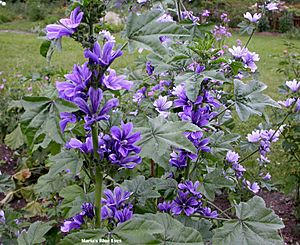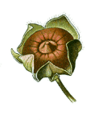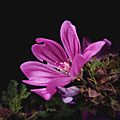Malva sylvestris facts for kids
Quick facts for kids Malva sylvestris |
|
|---|---|
 |
|
| Type species for Malva L. | |
| Scientific classification | |
| Genus: |
Malva
|
| Species: |
sylvestris
|
| Synonyms | |
|
|
The Common Mallow (scientific name: Malva sylvestris) is a type of flowering plant. It belongs to the mallow family, which is called Malvaceae. This plant is known by many names, like cheeses, high mallow, and tall mallow.
It originally grew in Western Europe, North Africa, and Asia. Over time, it spread to many other parts of the world.
Common Mallow is a strong plant with pretty, bright purple flowers. These flowers often have dark veins. The plant can grow quite tall, reaching about 3 to 4 feet (1 to 1.2 meters) high. You can often find it growing freely in meadows, along hedgerows, and in open fields.
Contents
Common Names for the Common Mallow
Sometimes, Malva sylvestris is called "Creeping Charlie." However, this name is more often used for a different plant called Glechoma hederacea, which is also known as ground ivy.
What Does the Common Mallow Look Like?
Common Mallow grows in many places, including parts of Iran and North Africa. In warmer areas like the Mediterranean, it lives for two years (a biennial plant). In other places, it lives for many years (a perennial plant).
The plant can grow straight up or spread out along the ground. It has branches and can be covered with fine, soft hairs, or sometimes no hairs at all. When it first starts to flower, it looks very nice. But as summer goes on, its leaves might lose their bright green color, and the stems can look a bit messy.
Leaves
The leaves of the Common Mallow grow on the stem. They are roundish and have many lobes, which are like rounded sections. Each lobe is about 2 to 4 centimeters (0.8 to 1.6 inches) long. The whole leaf can be 5 to 10 centimeters (2 to 4 inches) wide. The leaves have hairs that spread out from a central point, and you can see the veins clearly on the underside.
Flowers
The flowers of Malva sylvestris are often described as reddish-purple, bright pinkish-purple, or bright mauve-purple. They have dark stripes. These flowers grow in small groups of 2 to 4 where the leaves meet the stem. They open slowly along the main stem, with the flowers at the bottom opening first.
Each flower has a special outer layer called an epicalyx, which looks like a false calyx. It also has a true calyx with triangular parts. The flowers themselves are much larger than the calyx.
Fruits
The fruits of the Common Mallow are called nutlets. They are usually smooth and have a strong net-like pattern. There are typically 10 to 12 of these nutlets, and they are about 5 to 6 millimeters (0.2 inches) across.
Seeds
The seeds are also sometimes called 'cheeses' because they are shaped like a small cheese wheel. When they are ripe, they are brown to brownish-green. Each seed is about 2.5 millimeters (0.1 inches) long and 5 to 7 millimeters (0.2 to 0.3 inches) wide.
Where Does the Common Mallow Grow?
Malva sylvestris grows easily in wild and untended areas. You can find it along roadsides and railways in many parts of England, Wales, and the Channel Islands. It also grows in Siberia and other scattered locations.
This plant has been brought to new places like eastern Australia, the United States, Canada, and Mexico. In some of these areas, it has grown so well that it is now considered an invasive species, meaning it spreads quickly and can sometimes take over from native plants.
It is found naturally in many regions, including:
- Macaronesia: Azores, Madeira Islands
- Northern Africa: Algeria, Egypt, Libya, Morocco
- Western Asia: Afghanistan, Sinai, Iran, Israel, Jordan, Lebanon, Syria, Turkey
- Europe: Many countries across Northern, Middle, East, Southeastern, and Southwestern Europe, including the United Kingdom, Germany, France, Italy, and Spain.
How People Use Common Mallow
The word "mauve" for a color actually comes from the French word for mallow. This is because the flowers of the Common Mallow have a similar color.
In the past, people used Common Mallow for different things. In 1931, a writer named Maud Grieve noted that another plant, marsh-mallow (Althaea officinalis), was often preferred for its properties. However, Common Mallow was still a popular remedy for country people if marsh-mallow wasn't available.
Historically, the flowers were used to decorate doorways and were woven into garlands or chaplets for May Day celebrations. In the 19th century, the young leaves were boiled and eaten as a vegetable in several parts of Europe.
In countries like Morocco, Tunisia, and Palestine, the leaves of Common Mallow are steamed with garlic and tomatoes. They are then eaten as an appetizer or a salad. In Egypt, the leaves are used to make a stew-like vegetable dish called khobeiza, especially in winter. This dish is similar to Molokheia.
In traditional medicine, M. sylvestris has been used in herbalism. The plant, especially its fruit, contains a soothing substance called mucilage. The seeds can be made into a tea to help soothe the body internally. The leaves can be used in poultices (a soft, moist mass applied to the body) to help soften and soothe the skin.
The plant has also been used for a long time to make a natural yellow dye. Different shades of yellow-green dyes can be obtained from the plant and its seeds. A special liquid made from the flowers can even be used to test for alkalis.
Cultivation and Growing Common Mallow
Common Mallow is often grown as an ornamental plant because its flowers are very attractive. It produces flowers for a long time throughout the summer. Many different types, called cultivars, have been chosen and named for their unique features.
Some popular cultivars of Malva sylvestris include 'Annita', 'Blue Fountain', 'Magic Hollyhock', and 'Zebrina'. The 'Zebrina' cultivar is especially known for its soft lavender-purple flowers with deep maroon stripes.
Cultivar Groups
Gardeners and scientists group different types of Common Mallow together based on their features. For example, the Malva sylvestris L. Mauritiana group includes plants that were once thought to be a separate species called Malva mauritiana. These plants are often called Malva sylvestris var. mauritiana in gardens.
Other groups include the Eriocarpa group, which has hairy seeds and stems, found from Italy to the Himalayas. The Canescens group has dense white woolly hair on almost every part of the plant except the flower. There is also the Sterile Blue group, which includes pale violet-blue flowered types like 'Maria's Blue Eyes'.
Gallery
See also
 In Spanish: Malva común para niños
In Spanish: Malva común para niños











